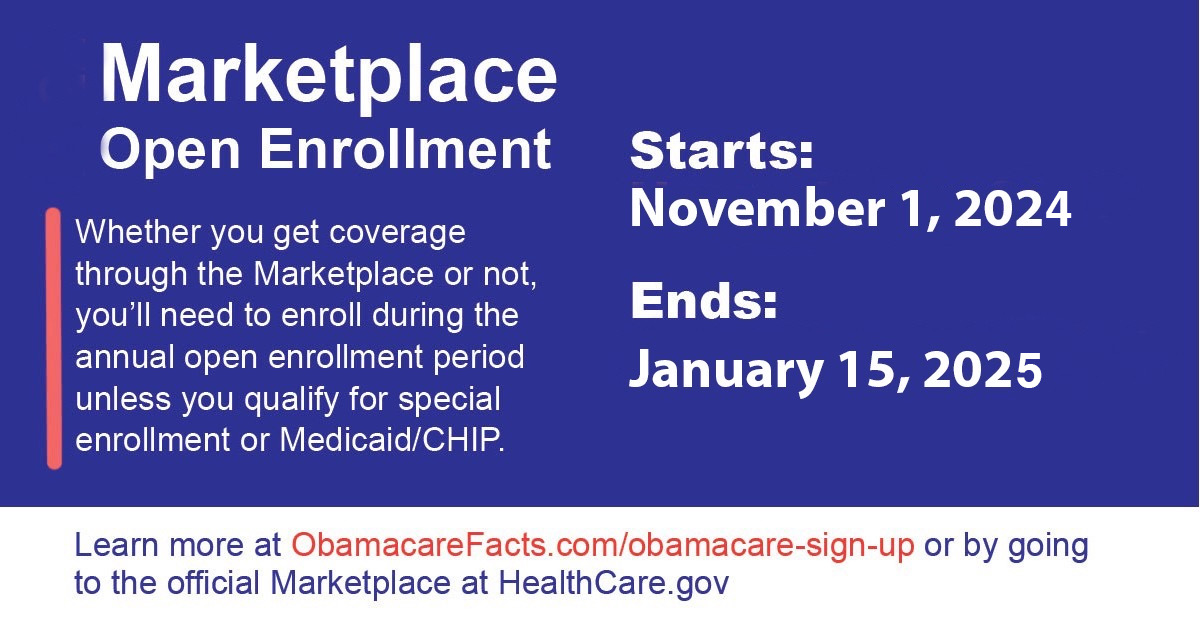ObamaCare Open Enrollment Period








When is Open Enrollment for ObamaCare, Medicaid, Medicare, and Other Insurance Types?
Open Enrollment is the annual window when you can enroll in, renew, or change ACA marketplace health plans and qualify for cost assistance.
For most states, Open Enrollment for 2026 coverage runs from November 1, 2025 through January 15, 2026. Some state-run exchanges extend deadlines into late January.
Outside Open Enrollment, ACA major medical plans are only available if you qualify for a
Special Enrollment Period (SEP), or if you qualify for other coverage types like
Medicaid,
CHIP, Medicare, or employer plans.
If you miss Open Enrollment, your options narrow considerably.
ACA / ObamaCare Open Enrollment 2026 (For 2026 Plans)
- November 1, 2025: Open Enrollment starts.
- December 15, 2025: Last day to enroll for coverage that starts January 1, 2026.
- January 1, 2026: Earliest coverage start date.
- January 15, 2026: Open Enrollment ends in most states.
- February 1, 2026: Coverage start date for enrollments submitted Dec 16–Jan 15.
TIP: Enrollment before the 15th of any month results in coverage that starts the 1st of the next month.
State-Specific ACA Enrollment Deadlines for 2026
Some states extend Open Enrollment past January 15. Final dates for 2026 will be added once each state confirms its deadlines.
Check your state at HealthCare.gov (states with their own exchanges will redirect you).
- California: Typically extends to Jan 31
- Colorado: Usually Nov 1 – Jan 15
- Connecticut: Usually Nov 1 – Jan 15
- District of Columbia: Historically allows Jan 31
- Idaho: Oct 15 – Dec 15 (earliest deadline)
- Kentucky: Typically until Jan 15–16
- Maine: Typically until Jan 15–16
- Maryland: Historically issues extensions
- Massachusetts: Historically extends to Jan 23
- Minnesota: Typically until Jan 15
- Nevada: Nov 1 – Jan 15
- New Jersey: Historically extends to Jan 31
- New Mexico: Nov 1 – Jan 15
- New York: Historically mid-Nov – Jan 31
- Pennsylvania: Nov 1 – Jan 15
- Rhode Island: Historically extends to Jan 31
- Vermont: Typically until Jan 15
- Washington: Typically until Jan 15
NOTE: Final 2026 deadlines pending. These follow prior-year patterns.
Other Coverage Types and Their Enrollment Periods
Medicaid & CHIP
Medicaid and CHIP are open for enrollment year-round. Eligibility depends on household income, disability status, and state rules.
Medicare
- Initial Enrollment: 3 months before–3 months after your 65th birthday month
- General Enrollment (Part A & B): Jan 1 – Mar 31
- Annual Election Period (Part C & D): Oct 15 – Dec 7
- Medicare Advantage Open Enrollment: Jan 1 – Mar 31 (switch or drop Advantage plans)
Learn more: Medicare enrollment periods
Employer Coverage
Open Enrollment periods vary by employer and typically occur in the fall.
Special Enrollment applies after qualifying life events.
Short-Term Health Insurance
Short-term health plans are available 365 days a year but do not:
- provide full ACA protections
- cover preexisting conditions in most cases
- qualify for ACA subsidies
What If You Miss the 2026 Open Enrollment Deadline?
If you miss Open Enrollment and don’t qualify for a Special Enrollment Period, you generally cannot buy ACA major medical coverage until the next November 1 cycle.
Alternatives include:
- Medicaid or CHIP (year-round)
- Medicare (if age-eligible)
- Employer coverage (varies)
- Short-term plans (temporary)
See: What to do if you missed the deadline
Historical ACA Open Enrollment Dates (SEO Archive)
These dates are retained for SEO value and user reference.
- 2014: Oct 1, 2013 – Mar 31, 2014
- 2015: Nov 15, 2014 – Feb 15, 2015
- 2016: Nov 1, 2015 – Jan 31, 2016
- 2017: Nov 1, 2016 – Jan 31, 2017
- 2018: Nov 1 – Dec 15, 2017
- 2019–2020: Nov 1 – Dec 15
- 2021–2024: Nov 1 – Jan 15 (permanent extension)
- 2025: Nov 1, 2024 – Jan 15, 2025
Most states in 2025 and 2026 follow the Nov 1 – Jan 15 model.
![]()